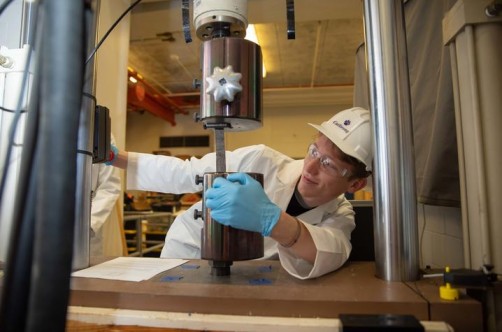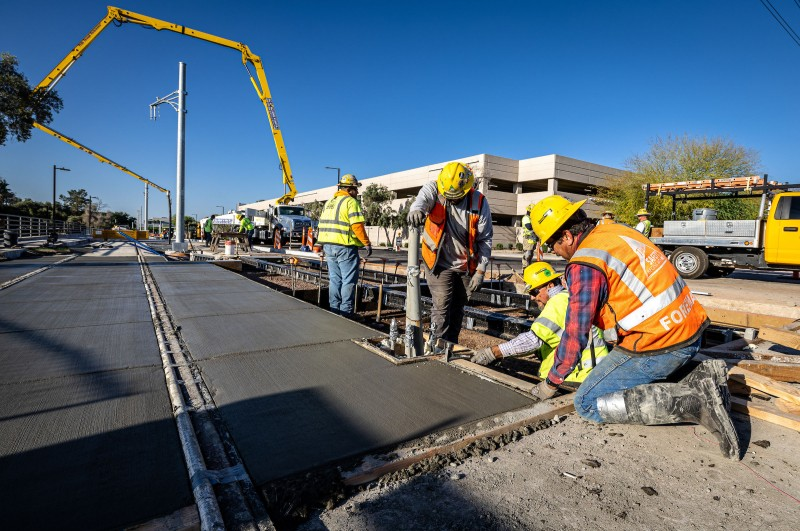The Infrastructure Investment and Jobs Act was signed by President Biden on Nov. 15, 2021, and authorized $1.2 trillion of investment through existing and new programs.
Among other provisions, this bill provides new funding for infrastructure projects, including:
- roads, bridges, and major projects;
- passenger and freight rail;
- highway and pedestrian safety;
- public transit;
- broadband;
- ports and waterways;
- airports;
- water infrastructure;
- power and grid reliability and resiliency;
- resiliency, including funding for coastal resiliency, ecosystem restoration, and weatherization;
- clean school buses and ferries;
- electric vehicle charging;
- addressing legacy pollution by cleaning up Brownfield and Superfund sites and reclaiming abandoned mines; and
- Western Water Infrastructure.
As hard-hit areas start to get funding for projects, finding ways to make that funding go further, and have greater impact on sustainability, has fallen on university researchers and departments. Experimenting and analyzing, innovating, and driving new technology to its limits has become the norm. And sometimes, all that work hangs by a thread—or a hair.
Bridges are a crucial component of infrastructure in all the states. They provide access between regions and cities and link workers to jobs. But as traffic continues to increase, bridges are aging at an accelerated pace. According to the American Road & Transportation Builders Assn., 7% of Kentucky’s bridges, as an example, are classified as “structurally deficient.”
What exactly does that mean? More than 1,100 bridges are rated in “poor condition.” At the University of Kentucky, that finding is a challenge. Since 1994, a group—comprising undergraduate, graduate, and even Fayette County high school students—has been investigating how to make the concrete construction process more sustainable.
Dubbed CatStrong, the team has been researching the deployment of FRP (fiber reinforced polymer) composites in bridges and buildings. Sponsored and led by Issam Harik, a professor in the Dept. of Civil Engineering, and Abheetha Peiris, a researcher at the Kentucky Transportation Center, CatStrong believes human hair is one of the answers.

While fiber producing plants and trees only grow in specific geographical regions, human hair grows in any region where humans live. Harik notes, “Since human hair, when trimmed, is generally discarded, it became a perfect candidate for our study.” The project involves analyzing, designing, and deploying concrete construction forms fabricated with human hair (fiber reinforcement). Peiris explains, “First, it’s cleaned with water and acidic liquid (lemon juice). Then, the hairs are mixed with a binder (water and grain flour). Lastly, the result is pressed into thin sheets to produce the concrete construction forms.”
Why human hair? “Human hair has an average strength of 30 kilopounds per square inch,” Harik explains. “That’s compared to 20 KSI for sheep wool, 60 KSI for steel rebars, and 70 KSI for silkworm fibers.”
Solving Structural Challenges
From design to development, students are involved in every aspect of CatStrong. Throughout the years, more than 70 undergraduates have been, and remain, an integral part of the research. Additionally, during the last two decades, more than 25 high school students have joined the team for a year or two at a time—a partnership between U. Kentucky and Fayette County Public Schools that serves as an invaluable experience. CatStrong students are currently experimenting with different ingredients for natural binders to determine the ideal mix and molding process.
This latest project builds upon the work completed by CatStrong, with human hair becoming part of a family of fiber reinforced products for structural repair. Using remarkably resilient carbon fiber fabrics, panels, and wraps, the group has successfully restored more than 40 Kentucky bridges by strengthening beams, columns, piles, and walls.
For example, in 2019 the team repaired one of the piles on the KY 32 bridge over Blaine Creek in Lawrence County using hemp—marking the first time the natural fiber has been used as a construction material for bridge repair.
Despite its success, CatStrong has been on a quest to find even more reliable resources. The goal is for the human hair-based materials to be replicated in any and all communities—a successful outcome that would continue to show the world what can be done.
Meanwhile, across the country in Arizona, the Metro Phoenix light rail has been confronting similar challenges. More than 60% of the volume of concrete used throughout the world has zero tensile efficiency and is unable to carry load. This makes concrete used in load-bearing structures, like the light rail, susceptible to cracks that begin very small and grow unhindered until there is a fault in the structure. The standard fix is to use reinforcing bar, or rebar, made of steel and embedded in concrete to strengthen structures.
Incorporating rebar provides the loadbearing strength required for most concrete-based construction. However, laying rebar is costly, leaves a dramatic carbon footprint, presents worker safety risks, and above all, takes a great deal of time. As the inevitable concrete cracking escalates and the rebar corrodes, additional maintenance, repair, and rehabilitation are required, further adding to costs and neighborhood disruption.
Using fiber-reinforced concrete instead of rebar-supported slabs for constructing rail extensions reduces months of construction time to weeks, adding cost savings, sustainability, and worker safety to the mix.
A collaboration between Arizona State University, the Phoenix Valley Metro Regional Transportation Authority and Kiewit-McCarthy, the project’s construction firm, began with a materials upgrade proposal from Barzin Mobasher, an ASU professor of structural engineering in the School of Sustainable Engineering and the Built Environment.
The project, which extended the light rail by 1.5 miles, incorporated the fiber-reinforced concrete design and was completed in early May 2023. Mobasher’s proposal simplified challenges for the light rail extension project and delivered a successful new system just by making one change in the design criteria—using fibers in the concrete mix instead of reinforcing with rebar.

Instead of using two layers of rebar in cross directions to support the light rail’s electrified track in the extensions, Mobasher’s design and validation approach considered both steel and polymeric fibers added directly into the concrete, eliminating the need for rebar reinforcement. Although steel fibers were chosen by Valley Metro for the northwest extension project, thin fibers of steel and polypropylene are being used in the concrete mixture for Phoenix Valley Metro’s other light rail extension.
To validate the proposal, a series of serviceability tests were conducted in ASU’s Structural and Materials Lab. Testing involved creating full-size mock-ups for both rebar-reinforced concrete and fiber-reinforced concrete, in the same ratios as full-size sections. Side-by-side testing allowed comparisons of strength and flexibility as well as documentation of concrete cracking and fatigue susceptibility.
The testing process also projected cost and construction time savings. For example, the per mile construction of the extension using rebar was projected at 231 days, while using fiber-reinforced concrete reduced it to 121 days, with a cost savings of more than $12 million.
“The idea of taking several long rebars that are half an inch in diameter, separated by 12 to 18 inches and built into a cage that is 12 inches above ground and replacing them with a fiber material, which is 2 inches long and only 1/32nd of an inch in diameter and mixed in with the concrete, might seem on scale non-competitive,” according to Mobasher.
“But if you have thousands of those small fibers distributed in there,” he continues, “they become much more effective in arresting the cracks—working as small Band-Aids to keep the cracks closed and transfer the load. (Fiber-reinforced concrete) can be designed to bear up to an unprecedented 40% of the tensile load capacity of concrete.”
Mobasher did a series of fatigue tests to simulate conditions for up to 45 years of service at much higher expected loads as proof of concept. “Valley Metro and the City of Phoenix accepted the proposed approach,” explains Mobasher. “It’s been a tremendous experience for them to save the volume of materials used and, at the same time, to be able to meet the project at costs much lower than the original budget and in a much faster time frame.”
Construction time
A major obstacle for community approval of light rail transit is months of neighborhood disruption during construction. Using fiber-reinforced concrete instead of rebar-supported designs significantly reduces disruption to weeks or, in some cases, days.
Andrew Haines, project manager for Jacobs Engineering in Tempe, reports, “There’s an accepted way of doing reinforced concrete in the United States, especially with regard to light rail. I think engineers get into this track of just, ‘We’ve got to do it a certain way, that’s how it’s always been done,’ and it’s been very difficult to change that—to accept something new.
“The placement of the concrete with the fibers has been very simple,” Haines said. “There’s no reinforcement—there are no bars in the track slab for workers to try to walk on and perhaps slip on. So, it’s just the prepared earth and the rails are in place and the concrete gets placed around it—the reinforcement is integral with the concrete.”
According to Mobasher, the fibers are added into the concrete mix at the plant before being transported by the ready-mix trucks to the construction site. The entire mix is then discharged and self-consolidates, leaving a smooth, finished concrete surface. “The work that used to take weeks to be done is finished in a matter of hours because we don’t need a crew laying up the steel rebars, connecting them, making sure they are all adequately welded together and that the components are all grounded”.
In addition to cutting worker and equipment costs, there are savings associated with shorter security requirements at construction sites and lower shipping and concrete production costs. Also, the traffic delays and lost productivity due to lane closures are significantly reduced.
And while there are significant cost savings due to switching from rebar to steel fibers, additional savings are realized by the different types of fibers as well. With steel versus polymetric fiber there’s a tremendous difference in weight. With rebar, “we’re using 65 pounds of steel,” Haines said. “The production of steel produces a lot of greenhouse gasses—and a lot of energy is required to produce steel. There’s a lot less energy in using polymeric and synthetic fibers. We’re only using 12 pounds of polypropylene fibers vs. 65 pounds of steel, so there’s a savings there.”
The whole purpose of sustainable engineering is to design the material at a different level that may not sound intuitive, but that has load-bearing qualities that enhance longevity while reducing the carbon footprint. Additionally, the testing validates stability for more than 45 years, with a likely service life under Phoenix climate conditions of more than 100 years.
Want to tweet about this article? Use hashtags #construction #sustainability #infrastructure


